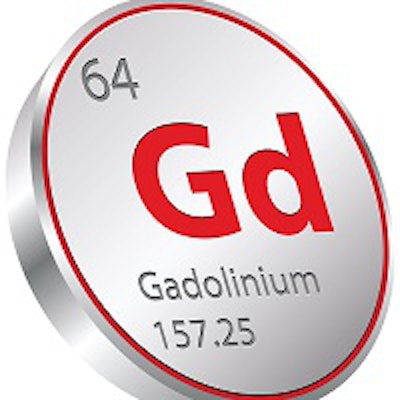
A new study has found that deposition of gadolinium from MRI contrast in brain and bone tissue could be more common than previously thought. Researchers found traces of gadolinium in patients who received a class of MRI contrast agents that are more stable and thus were thought to be less prone to deposition.
The findings contradict previous in vivo studies that showed no MRI signal increase from gadolinium in patients who received the more stable contrast agents, as opposed to the agents that previously have been associated with gadolinium deposition.
The researchers from the University of Washington (UW) in Seattle confirmed minute traces of gadolinium from the more stable gadolinium-based contrast agents (GBCAs), with greater concentrations in cortical bone than in brain tissue. The question is what the findings actually mean, and whether they will affect the use of gadolinium contrast.
The GBCA debate
The latest controversy over gadolinium contrast began in 2014, when a study by Kanda et al was published that raised concerns about significantly higher levels of gadolinium found in the dentate nucleus and globus pallidus regions of the brain.
The agents involved in these studies tended to be a generation of MRI contrast called linear standard relaxivity GBCAs, due to the way in which they bind gadolinium molecules to a ligand that gives it stability. Problems with gadolinium contrast are believed to occur when the gadolinium ion breaks away from the ligand, releasing free gadolinium (a toxic substance) into the body.
GBCAs based on linear standard relaxivity structures are considered by the U.S. Food and Drug Administration (FDA) to have a greater risk of causing nephrogenic systemic fibrosis in patients who have impaired renal function, and are referred to as group 1 agents.
Two other generations of GBCAs, called group 2 agents, are believed to have more stable chemical structures, reducing the risk of free gadolinium breaking away. They consist of macrocyclic agents as well as high-relaxivity protein binding agents.
In the current study, the University of Washington group sought to determine whether gadolinium deposition occurred among patients who only received gadolinium contrast products not in the group 1 class. They measured accumulations using postmortem tissue analysis with a highly sensitive tool, inductively coupled plasma mass spectrometry (ICP-MS).
Tissue comparisons
Brain tissue was collected at autopsy from patients who had medical and imaging records that confirmed they had undergone at least one contrast-enhanced MRI scan during their lifetime. Patient records also specified which GBCA they received and dose amounts of the agent (Investigative Radiology, February 8, 2016).
After reviewing 134 autopsy cases, the researchers identified nine patients who received one or more injections of one type of the newer GBCA agents. Five patients were given gadoteridol (ProHance, Bracco Diagnostics); two patients received gadobutrol (Gadavist, Bayer HealthCare Pharmaceuticals); and one person each received gadobenate (MultiHance, Bracco) and gadoxetate (Eovist, Bayer).
Senior author Dr. Kenneth Maravilla and colleagues also created a second group of nine control patients, also deceased, who never had an MRI scan, never received a GBCA, and showed gadolinium levels at or below limits of measurement in all brain tissue areas, including the globus pallidus and dentate nucleus.
The researchers collected tissue samples from the white matter, putamen, globus pallidus, caudate nucleus, pons, and dentate nucleus. In addition, they analyzed bone tissue from the ribs as a reference tissue for each case. The data were correlated with the agents that were administered and their dosage.
Brain vs. bone
The group found remnants of gadolinium from all the GBCAs in all brain areas after just one dose, with the greatest level of deposits in the globus pallidus (range, < 0.005-0.625 micrograms per gram of tissue) and dentate (range, < 0.004-1.07).
Among the controls, gadolinium levels in the brain were at or below limits of measurement and were significantly lower than all other study cases.
 Dr. Kenneth Maravilla from the University of Washington.
Dr. Kenneth Maravilla from the University of Washington.Most interestingly, the spectrometry tests showed a much higher level of gadolinium deposition in bone than brain tissue in all of the study's cases. For example, the gadolinium concentration was at least nine times greater in bone (median, 23 times greater) compared with the globus pallidus.
What it all means
While the study provides no definitive answer to the overriding question of whether GBCAs cause long-term harm to patients years after administration, it offers additional information on how to approach their use.
One positive result is that the study "confirms what we already believe: Namely that some of these agents, like the macrocyclic and, to some extent, the linear protein agents, appear to deposit less gadolinium than group 1 agents," Maravilla, who is director of UW's MR Research Laboratory, told AuntMinnie.com. "This is important knowledge for people who may want to modify their procedures for the future."
To put the results in perspective, Maravilla emphasized that the gadolinium deposits in brain and bone tissue are "very, very tiny amounts; we are talking nanogram range."
He also speculated that the greater presence of gadolinium in bone tissue may be "because of gadolinium being somewhat similar to calcium in terms of its chemical properties and molecular size."
Still, the study did find measurable amounts of gadolinium in bone tissue compared to brain tissue. These results are "a little concerning," Maravilla said, noting two issues.
One is that the levels detected represent a very small amount gadolinium, "but no one knows what the long-term history of that gadolinium is, especially if someone were to develop very severe metabolic disease or go into renal failure," he said. "Is this due to the gadolinium in the bone? We don't know that."
The second issue is the kind of gadolinium present and whether it is associated with any previously researched ailments.
"Now we are focused on taking this to the next level to determine what form these gadolinium agents are in, and are they likely to be of concern or no concern. It may be different for different compounds," he said.
Another idea is the possibility of using the amount of gadolinium in the bone as a surrogate to estimate gadolinium in the brain.
"Right now, there is no great need to do that," Maravilla conceded. "That [finding] may not be key right now, but it is a possibility that at some time in the future it could become key."
UW's protocols
The findings have not changed the way UW chooses and administers its GBCAs. Maravilla said the facility has tried to limit itself to using the newer agents, which appear to be safer than the group 1 agents that are subject to the FDA's black-box warning.
"The one danger is that we do not know what the long-term effects are," he said. "So far there have not been any demonstrated long-term effects. What I would hate to see is gadolinium use restricted so that patients who need this agent for diagnosis and treatment planning don't have full access to it."
So far, one confirmed risk is NSF, which was linked to the use of certain GBCAs in patients with insufficient renal function.
"Having said that, I think it behooves us to use the safest agents -- ones that appear to be most stable in vitro, outside of the body in experimental studies -- when examining patients," Maravilla said. "For the most part, they seem to have the least deposits in the studies we have done."


.fFmgij6Hin.png?auto=compress%2Cformat&fit=crop&h=100&q=70&w=100)





.fFmgij6Hin.png?auto=compress%2Cformat&fit=crop&h=167&q=70&w=250)











